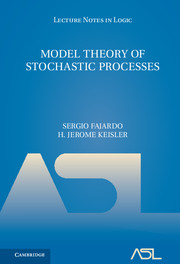Book contents
- Frontmatter
- Dedication
- Contents
- Introduction
- Chapter 1 Adapted distributions
- Chapter 2 Hyperfinite adapted spaces
- Chapter 3 Saturated spaces
- Chapter 4 Comparing stochastic processes
- Chapter 5 Definability in adapted spaces
- Chapter 6 Elementary extensions
- Chapter 7 Rich adapted spaces
- Chapter 8 Adapted neometric spaces
- Chapter 9 Enlarging saturated spaces
- References
- Index
Chapter 8 - Adapted neometric spaces
Published online by Cambridge University Press: 30 March 2017
- Frontmatter
- Dedication
- Contents
- Introduction
- Chapter 1 Adapted distributions
- Chapter 2 Hyperfinite adapted spaces
- Chapter 3 Saturated spaces
- Chapter 4 Comparing stochastic processes
- Chapter 5 Definability in adapted spaces
- Chapter 6 Elementary extensions
- Chapter 7 Rich adapted spaces
- Chapter 8 Adapted neometric spaces
- Chapter 9 Enlarging saturated spaces
- References
- Index
Summary
In this chapter we will establish additional properties of rich adapted spaces which can be applied to stochastic analysis. In Sections 8.1 and 8.2 we give an overview of the theory of neometric spaces, culminating in the Approximation Theorem. Section 8.C gives some typical applications of this theorem.
We briefly survey the evolution of the ideas in this chapter. The paper “From discrete to continuous time”, Keisler [1991], introduced a forcing procedure, resembling model theoretic forcing (see Hodges [1985]), which reduced statements about continuous time processes to approximate statements about discrete time processes without going through the full lifting procedure. After some refinements, in the series of papers Fajardo and Keisler [1996a] – Fajardo and Keisler [1995] we worked out a new theory, called the theory of neometric spaces, which has the following objectives: “First, to make the use of nonstandard analysis more accessible to mathematicians, and second, to gain a deeper understanding of why nonstandard analysis leads to new existence theorems. The neometric method is intended to be more than a proof technique—it has the potential to suggest new conjectures and new proofs in a wide variety of settings.” (From the introduction in Keisler [1995]).
This theory developed an axiomatic framework built around the notion of a neometric space, which is a metric space with a family of subsets called neocompact sets that are, like the compact sets, closed under operations such as finite union, countable intersection, and projection. In particular, for each adapted probability space there is an associated neometric space of random variables, and the adapted space is rich if the family of neocompact sets is countably compact.
In this book we take advantage of the results in the more recent paper Keisler [1997a] to give a simpler approach to the subject. In the Chapter 7 we defined rich adapted spaces directly without introducing neocompact sets. In this chapter we will give a quick overviewof the theory of neometric spaces. The neocompact sets will be defined here as countable intersections of basic sections, and their closure properties will be proved as theorems which hold in any rich adapted space.
- Type
- Chapter
- Information
- Model Theory of Stochastic Processes , pp. 115 - 124Publisher: Cambridge University PressPrint publication year: 2002



